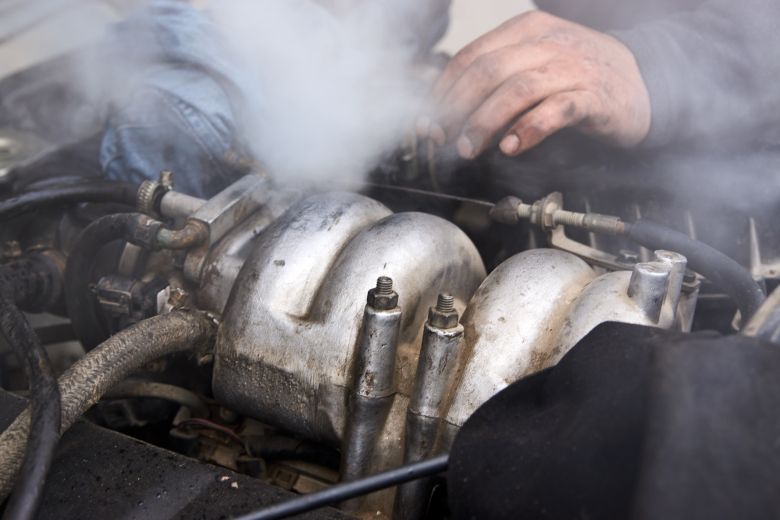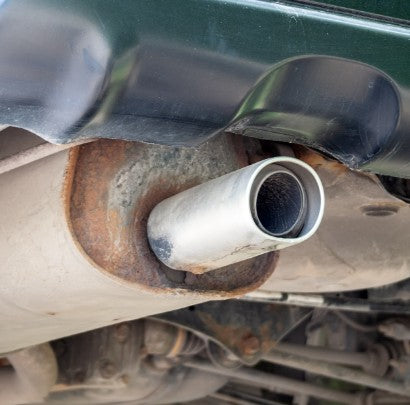Can a Bad Egr Valve Cause White Smoke
Yes, a bad EGR (Exhaust Gas Recirculation) valve can cause white smoke if it sticks open. This problem leads to coolant entering the combustion chamber.
A vehicle’s EGR valve plays a crucial role in reducing emissions by recirculating a portion of the exhaust gases back into the engine’s combustion chamber. A malfunctioning EGR valve can introduce several problems, including the unusual emission of white smoke from the exhaust, which often indicates a more severe issue.
White smoke typically suggests the presence of coolant in the engine, which can occur if the EGR cooler has a leak or if the valve is stuck open, allowing coolant to seep into the cylinders. This symptom should prompt immediate attention, as it can lead to significant engine damage if left unaddressed. Addressing EGR valve issues quickly helps maintain engine performance and adhere to emission standards, avoiding more costly repairs down the line.
Signs Of A Faulty Egr Valve
The Exhaust Gas Recirculation (EGR) valve plays a crucial role in reducing emissions in vehicles. It reroutes some of the exhaust gases back into the combustion chamber to cool down the engine and reduce the formation of harmful gases. However, like any component, it can fail, leading to a range of issues, including white smoke from the tailpipe. Let’s explore the signs that may indicate a problematic EGR valve.
Unusual Exhaust Smoke
White smoke can be alarming, and often points to a bad EGR valve. The EGR valve helps in controlling the temperature and prevents the engine from running too hot. A failing valve might cause coolant to leak and get burned, resulting in white smoke. This smoke is different from the harmless water vapor you might see on a cold day. Keep an eye out for thick white smoke, which may signal an EGR valve issue that needs immediate attention.
Performance Issues And Stalling
A faulty EGR valve can seriously impact your car’s performance. You might notice that your vehicle struggles to accelerate or lacks power. Such performance issues can stem from an EGR valve stuck open or close, altering combustion and affecting the engine’s power output. If your car stalls frequently, it’s another clear sign. When the EGR valve fails, it disrupts the engine’s air-to-fuel ratio, leading to rough idling or even unexpected stalling. Tackling these symptoms early can prevent further engine complications.
Remember, these signs can also indicate other issues, but they are common symptoms of a faulty EGR valve. Regular maintenance and prompt action at the first sign of trouble can keep your vehicle running smoothly.

Credit: m.youtube.com
Link Between Egr Valve And Exhaust Smoke
Ever noticed white smoke billowing from your car’s exhaust and wondered if it links to the EGR valve? Understanding this relationship is key to maintaining your vehicle’s health.
Role Of The Egr In Engine Management
The Exhaust Gas Recirculation (EGR) valve plays a critical role in your car’s engine efficiency and emissions control. By recirculating a portion of the exhaust gases back into the combustion chamber, the EGR valve helps:
- Reduce nitrogen oxide emissions by lowering combustion temperature.
- Improve engine longevity by minimizing detonations in the cylinders.
How A Compromised Egr Can Lead To Smoke
When the EGR valve malfunctions, it can cause a range of engine issues, including the emission of white smoke from the exhaust. This occurs because:
- A stuck open EGR valve can cause coolant to burn, leading to white smoke.
- An unwanted air-fuel mixture can lead to incomplete combustion, another white smoke cause.
| EGR Issue | Potential Signs | Result |
|---|---|---|
| Stuck Open/Closed Valve | White Smoke, Rough Idle | Engine Performance Drops |
| Leaking EGR Cooler | Coolant Loss, White Smoke | Coolant burns in chambers |
To sum up, a bad EGR valve might send white smoke out of your tailpipe. It’s a clear sign to check your engine’s EGR system. Regular checks and maintenance of the EGR valve can prevent this unwanted exhaust smoke. Keep your engine happy and the air cleaner by paying attention to that pesky valve.
Characteristics Of White Smoke
The tailpipe tells tales of your vehicle’s health, and white smoke is one of its narratives. This ethereal puff sends a signal that commands attention. Within the smoke’s characteristics lie clues to potential auto ailments. Let’s explore these smoky signals to keep our engines in prime condition.
Normal Vs. Problematic Smoke
Not all smoke is a sign of trouble. Some mist on startup is normal, especially in cold weather. This happens when condensation inside the exhaust system heats up. Yet, white smoke that lingers is a red flag. It often indicates coolant entering the combustion chamber. This trouble smoke can be thick and consistent.
Characteristics of white smoke that suggest an issue include:
- Continuous emission during engine operation
- Consistency that is thicker and more opaque than morning mist
- A sweet smell, hinting at antifreeze
Diagnosing Egr Valve Failure Through Smoke
An EGR (Exhaust Gas Recirculation) valve helps reduce emissions by recirculating a portion of an engine’s exhaust gas back to the engine cylinders. When it fails, it might cause your engine to burn coolant, which results in white smoke. A bad EGR valve can lead to significant engine damage if not addressed promptly.
Signs of EGR valve failure that can be seen through smoke:
| Smoke Quality | Probable Cause |
|---|---|
| Persistent white smoke | Leaking coolant due to EGR cooler failure |
| White smoke with a sweet smell | Combustion of ethylene glycol from a faulty EGR system |
Inspection should come sooner rather than later. White smoke may escalate from a warning whisper to a shout of engine distress. Be proactive in diagnosing and fixing EGR valve issues to keep your engine running smoothly and your emissions clean.
Troubleshooting White Smoke Issues
When your vehicle starts emitting white smoke, it’s crucial to address the problem immediately. The smoke can signal anything from a simple fix to a serious issue that could damage your engine. Pinpointing the exact cause is essential.
Steps For Identifying The Cause
Begin with a visual inspection. Look for telltale signs under the hood. Check fluid levels and inspect for leaks. Once you’ve ruled out external issues:
- Examine the exhaust for excessive moisture or a sweet smell, which might indicate coolant leakage.
- Monitor your vehicle’s performance for signs of diminished power or rough idling, which can provide clues.
Carry out these checks when the engine is cold for safety.
Engine diagnostics can reveal deeper issues. Employ an OBD-II scanner if your vehicle is equipped:
- Connect the scanner to your vehicle’s diagnostic port.
- Follow the on-screen prompts to read the codes.
- Note any codes that could indicate malfunctions related to the exhaust or EGR system.
Consult your vehicle’s manual to understand the relevance of these codes.
When To Suspect The Egr Valve
Focus on the EGR (Exhaust Gas Recirculation) valve when the white smoke is accompanied by a specific set of symptoms:
| EGR Valve Symptom | Related White Smoke Characteristic |
|---|---|
| Sticky residue | Constant white smoke, fouled spark plugs. |
| Malfunctioning EGR | Thick, white smoke and reduced engine power. |
| EGR Cooler Failure | White smoke on startup, possible coolant smell. |
Analyze smoke patterns and check engine light behavior. If your vehicle showcases these symptoms, the EGR valve may require attention. Professional mechanic advice is advisable.
Repairing A Defective Egr Valve
Discovering white smoke billowing from your car’s exhaust can raise alarms. A defective Exhaust Gas Recirculation (EGR) valve might be the culprit. This critical component, designed to reduce pollution, can malfunction. The EGR valve guides harmful gases back into the combustion chamber for a second burn, reducing emissions. Fixing a defective EGR valve restores engine performance and stops white smoke.
Common Egr Valve Problems
Understanding common EGR valve issues helps determine the right fix. Here are frequent problems:
- Carbon Buildup: Blocks the valve’s movement.
- Sticking Valve: Affects engine airflow.
- Vacuum Leaks: Disrupts the valve’s operation.
- Failed Solenoid: Interrupts electrical connections.
Repair Or Replace: Making The Right Choice
Once you spot a problem, deciding between repair or replacement is crucial.
| Repair | Replace |
|---|---|
| Clean carbon buildup | Old or heavily damaged EGR |
| Fix sticking valve | Broken components beyond repair |
| Seal vacuum leaks | Updated model available with better performance |
| Repair solenoid connections | Repair costs exceed replacement |
Conduct a thorough inspection before deciding. Choose a repair for minor issues. Opt for a replacement when facing major faults or when repairs are not economical.

Credit: m.youtube.com
Preventive Measures And Regular Maintenance
Keeping your EGR (Exhaust Gas Recirculation) valve in top shape is vital. A faulty EGR valve can lead to white smoke from the exhaust. This white smoke signals potential engine trouble. Fortunately, routine checks and proper care can prevent these issues. Let’s explore the best ways to maintain your EGR valve for optimal performance and avoid unwelcome surprises.”
Routine Checks For Egr System Health
Regular inspections of your vehicle’s EGR system ensure it functions correctly.
- Visual Examination: Check the EGR valve for signs of damage or buildup.
- Performance Testing: Monitor your car for rough idling or stalling.
- Diagnostic Scans: Use an OBD-II scanner to identify error codes related to the EGR system.
Staying on top of these checks helps spot issues before they escalate.
Best Practices To Avoid Egr-related Problems
Adopting certain habits can help maintain your EGR valve:
| Action | Benefit |
|---|---|
| Use quality fuel | Minimizes carbon deposits |
| Regularly replace filters | Ensures clean airflow |
| Timely service appointments | Maintains system health |
Clean the EGR valve if you notice increased emissions or a decrease in engine performance.
- Detach the battery.
- Remove the valve.
- Clean with a specialized cleaner.
- Reinstall and reconnect everything.
These steps help prevent EGR problems and keep your engine running smoothly.

Credit: otrperformance.com
Frequently Asked Questions For Can A Bad Egr Valve Cause White Smoke
Can Egr Valve Failure Cause White Exhaust Smoke?
A failing EGR valve can lead to incorrect air-to-fuel ratios. This imbalance may cause the engine to run rich, leading to white smoke from the exhaust.
What Are Signs Of A Bad Egr Valve?
Symptoms include rough idling, reduced fuel efficiency, and the Check Engine Light turning on. Stalling and a drop in engine performance can also indicate a faulty EGR valve.
How Does Egr Valve Affect Engine Smoke Color?
The EGR valve controls NOx by recirculation. A malfunction can disrupt the combustion process, potentially causing white or black smoke, depending on the specific issue.
Can Cleaning An Egr Valve Fix White Smoke?
Cleaning a clogged EGR valve can restore proper function. If the white smoke was due to EGR-related issues, cleaning might resolve the problem without needing replacement.
Conclusion
Understanding your vehicle’s EGR valve function is essential for engine health. A faulty EGR valve indeed can lead to white smoke emissions, signaling deeper engine concerns. Regular checks and timely replacements will safeguard your car’s performance and maintain its longevity.
Remember, clear exhaust is a sign of a healthy engine! Keep an eye out for white smoke and address EGR issues promptly.




